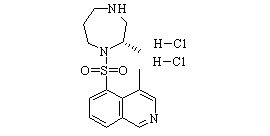(S)-H-1152 (hydrochloride)
| CAS No. | 451462-58-1 | Cat. No. | BCP16935 |
| Name | (S)-H-1152 (hydrochloride) | ||
| Synonyms | H-1152;H 1152;H1152;BRD7446 Dihydrochloride; | ||
| Formula | C16H23Cl2N3O2S | M. Wt | 392.34 |
| Description | in vitro: H-1152 dose-dependently inhibited the phosphorylation of MARCKS in human neuroteratoma (NT-2) cells stimulated by Rho-activator lysophosphatidic acid (LPA), which was determined by phosphorylation site-specific antibody against phospho-Ser159 in MARCKS, whereas it hardly inhibited the phosphorylation stimulated by phorbol-12,13-dibutyrate (PDBu) . Loss-of-function experiments in endothelial cells revealed that inhibition of ROCK I/II using the pharmacological inhibitor H-1152 and ROCK I/II-specific small-interfering RNAs resulted in a rise of VEGF-driven sprouting angiogenesis. in vivo: Cumulative addition of H-1152 (0.001-3 microM) or Y-27632 [0.01-30 microM; (R)-(+)-trans-N-(4-pyridyl)-4-(1-aminoethyl)-cyclohexanecarboxamide] caused sustained relaxations of precontracted CC strips, which were not affected by inhibition of the nitric oxide signaling pathway. Addition of H-1152 (0.1 microM), Y-27632 (1 microM), or sodium nitroprusside (SNP; 0.1 microM) caused rightward shifts | ||
| Pathways | Cell Cycle/DNA Damage TGF beta/Smad Wnt/Stem Cell | ||
| Targets | ROCK | ||
Structure

Part data of this page collected from the open network resources, so Biochempartner can not guarantee its accuracy.
For product details of different batches, please contact our Customer
- Service & Tech Support:orders@biochempartner.com
- Website:www.biochempartner.com
Products are for research use only and not for human use. We do not sell to patients.
